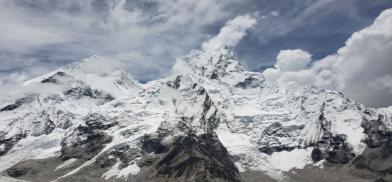Global warming impacting Mt Everest: Is it also turning into the world's highest garbage dump?
Mount Everest’s glaciers have lost 2,000 years of ice in just the past 30 years, according to recent research. This is not only alarming for those residing in the mountainous areas but also poses a threat to everyone in the region, particularly those living downstream. Much of South Asia depends on rivers that originate in the Himalayas for agriculture and drinking water.

Festivities around the 70th anniversary of the conquest of Mount Everest this year were dampened by concerns about rising temperatures, melting glaciers and harsh, erratic weather conditions on the world’s tallest mountain.
The 29 May 1953 expedition by New Zealander Edmund Hillary and Nepali Tenzing Norgay Sherpa changed mountaineering forever. Nepal began celebrating the anniversary as Everest Day after Hillary’s death in 2008. The 8,849-metre peak now witnesses thousands of climbers a year, with scores buried on its unpredictable slopes.
Hundreds from the mountaineering community, Sherpa guides and officials rallied in Kathmandu on 29 May to mark the anniversary. Participants waved celebratory banners and marched in Kathmandu city centre to tunes played by military bands.
Many also raised concerns about the deteriorating conditions on Mt. Everest and the mountaineering community, whose livelihoods depend on the flow of visitors.
While global warming has impacted the entire world, the effects of climate change have been particularly severe in the Himalayan heights, with rising rates of snow melt and glaciers and lakes drying up.
Prominent Sherpa Ang Tshering, who grew up on the foothills of the mountains, told AP that he remembers sliding on the glacier near his village. The glacier does not exist today.
Other Sherpas have also observed changes in the Khumbu Glacier at the foot of Everest, near the base camp. According to Sherpa Phurba Tenjing, who has been climbing Everest since he was 17, both the snow and ice have melted, because of which the trek that used to take five or six hours over the icy path now only takes half an hour.
Mount Everest’s glaciers have lost 2,000 years of ice in just the past 30 years, according to recent research. This is not only alarming for those residing in the mountainous areas but also poses a threat to everyone in the region, particularly those living downstream. Much of South Asia depends on rivers that originate in the Himalayas for agriculture and drinking water. There is also an added risk of extreme floods and droughts, a growing phenomenon in recent years.
Harsh weather conditions have also caused an unprecedented number of deaths this year. As many as 17 people died on the mountain this season, stated Nepal tourism department head Yuba Raj Khatiwada.
“The main cause is the changing weather. This season the weather conditions were not favourable, it was very variable. Climate change is having a big impact on the mountains,” said Khatiwada.
World’s highest garbage dump
Besides climate concerns, Everest has also turned into the world’s highest garbage dump. Everest Today, a media outlet dedicated to the mountain, recently uploaded a video clip on Twitter to highlight the concerning amount of abandoned tents, trash and other plastic waste that have accumulated at Camp IV.
EMBED TWEET: https://twitter.com/EverestToday/status/1662880927050240000?s=20
Each climber on Everest generates about eight kilograms of waste, including food containers, tents, empty oxygen tanks and even human faeces, estimates the National Geographic. The influx of climbers, combined with inadequate waste management practices, has turned the site into the "world's highest garbage dump."
While Nepal has implemented a mandatory requirement for climbers to bring down their waste and reclaim their garbage deposit of USD 4,000, it is challenging to monitor camps situated nearly 8,000 metres (26,246 feet) high, say local officials and expedition organisers
(The author is a digital journalist, visual storyteller, and researcher based in New York who previously working as a journalist in Pakistan. By special arrangement with Sapan)









Post a Comment